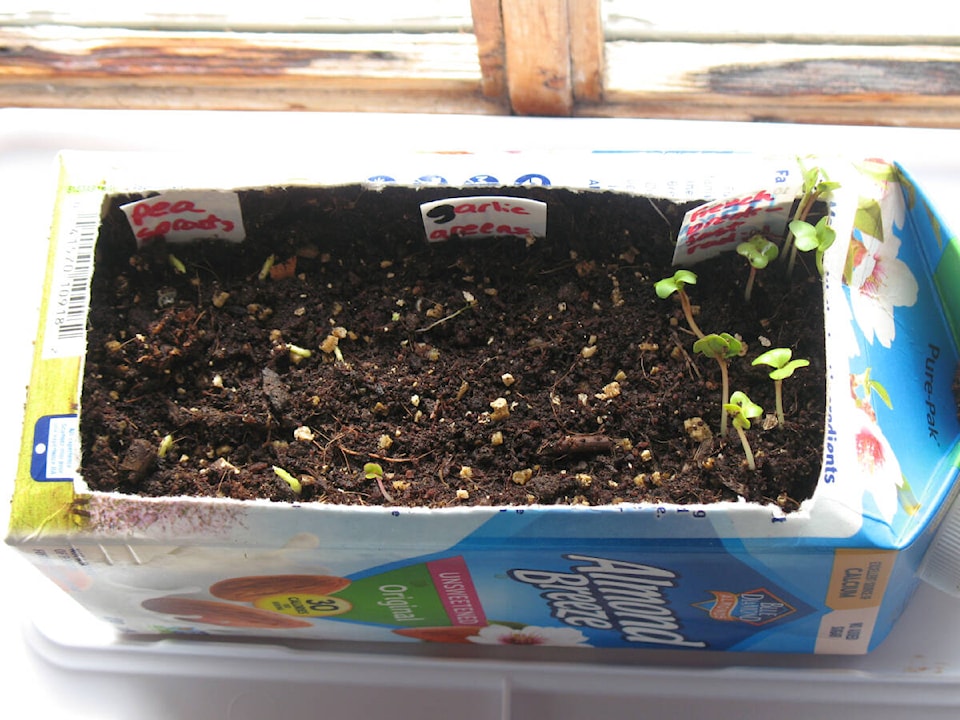By Mary Lowther
My children soon learned to stop complaining of boredom after I found chores for them, but brightened up when it involved growing plants, and not just for science projects. Gardening can be fun, the enjoyment of literally fruitful labour, and demonstrates the value of work for reward. It also gets the kids out of the house and away from the devices that own them.
When David was four years old the neighbour across the fence was a retired veteran of two world wars who lifted him over the fence and taught him how vegetables happened. Unfortunately, it didn’t occur to Mr. Schram to discuss the passage of time until after David dug up the peas to see how they were doing, two days later. Patience is only one of many things gardening can teach us.
In her booklet Grow it Again author Elizabeth McLeod has compiled some terrific gardening projects for kids (and adults like me) who like to do a little experimenting, using vegetable scraps and seeds. For example, the tops of roots like carrots, beets and turnips may sprout leaves, especially if they show buds or tiny leaves already. Organically grown vegetables grow more reliably.
McLeod suggests putting a layer of stones in the bottom of a container and placing the root top cut side down on the stones, adding enough water to cover the cut side and placing it in a sunny window. Check it every day to make sure the cut side is under water and green leaves should start shooting out in a few days. Beet or turnip leaves may get big enough for a meal, and when kids grow their own vegetables they’re more likely to eat them. Some of the tops may produce flowers as well.
Sweet potatoes can be grown the same way, using a deep bowl and a deeper layer of stones because the roots of sweet potatoes are profuse. Cut a five centimetre piece from the round end, that’s the top, then place the potato cut side down on the stones and cover the cut part with water, adding fresh water as needed. Leaves should sprout out of the top and sides within a week; if they haven’t, try it with a different sweet potato.
McLeod goes on to say that pineapple tops can also be grown this way and their leaves can grow on for years. Once roots appear, move the pineapple top to a pot with a mixture of soil and sand, ensuring that the whole base of the pineapple is covered.
Try growing seeds from watermelons, apples, squash and dry beans. Two years ago I bought a dumpling squash, grew its seeds and got several fruit from them whose seeds still produce tasty squash. Just for fun, I followed another of McLeod’s suggestions and washed out an empty milk carton, kept the plastic cap on and cut out one side. I added a layer of stones, filled the rest with potting soil, added some seeds, patted them down and sprinkled more potting soil on top. I watered it lightly and covered this with a clear plastic top that I removed once seeds sprouted. When the peas reach a few inches I’ll cut the sprouts and add them to salads.
When I mentioned this to David he asked if I remembered the beehive at the old provincial museum, sandwiched between sheets of glass so you could watch the internal hive. A glass container that allows kids to actually watch the roots grow down as well might be worth trying. A smallish fish tank can be repurposed as a horticultural laboratory.
Grow It Again can be obtained from Kids Can Press, Ltd., in Toronto. David can often be found drinking tea at the Country Grocer. Be sure to order a beverage before asking about Mr. Schram or the bee hive because you might be there for a while.
Please contact mary_lowther@yahoo.ca with questions and suggestions since I need all the help I can get.
